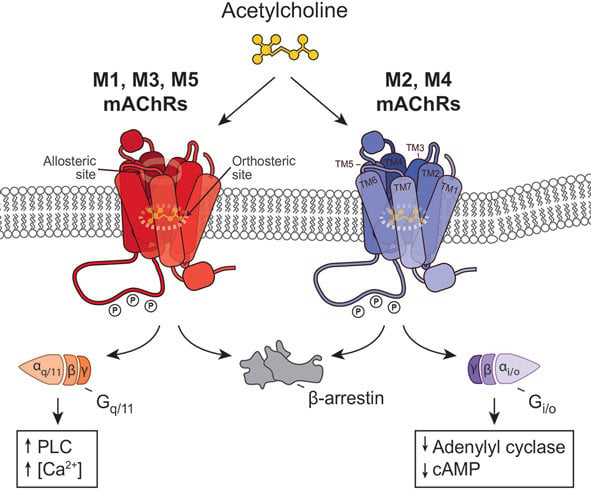-
muscarinic receptor antagonist
Biperiden hydrochloride is a muscarinic receptor antagonist that displays some selectivity for the M1 subtype -
AChR antagonist
Fesoterodine fumarate is a medicine which is used in urinary urgency, reducing the frequency of passing urine and urge urinary incontinence -
mAChR M2 antagonist
Gallamine Triethiodide is a mAChR M2 antagonist with pronounced cardioselectivity. - Ipratropium bromide is a muscarinic antagonist, bronchodilator, N-Isopropyl salt of atropine.
-
AchR antagonist
Rocuronium Bromide is a competitive AchR antagonist, used in modern anaesthesia. -
muscarinic receptor antagonist
SVT-40776 is a novel M3 muscarinic receptor antagonist, for the treatment of overactive bladder. -
muscarinic acetylcholine receptor (mAChR) antagonist
Tiotropium Bromide (BA679 BR) is a muscarinic acetylcholine receptor (mAChR) antagonist that blocks the binding of the acetylcholine ligand and subsequent opening of the ligand-gated ion channel. -
muscarinic receptor antagonist
Tolterodine tartrate (Detrol LA) is a muscarinic receptor antagonist which is used for the treatment of urinary incontinence. -
muscarinic receptor antagonist
5-hydroxymethyl tolterodine is a metabolite of Tolterodine, a muscarinic receptor antagonist used in the treatment of urinary incontinence.
-
muscarinic M3 receptor antagoinst
Solifenacin-succinate is a muscarinic M3 receptor antagoinst, used in treatment of urinary incontinence. -
NMDA receptor antagonist
Orphenadrine citrate is a NMDA receptor antagonist with Ki of 6.0 +/- 0.7 μM, HERG potassium channel blocker. -
acetylcholine receptor antagonist
Beperidium iodide shows a competitive antagonistic effect against acetylcholine receptor with a pA2 of 7.93. -
muscarinic antagonist
Glycopyrrolate is a muscarinic competitive antagonist used as an antispasmodic. -
muscarinic M(3) receptor antagonist
PF-3635659 is a potent muscarinic M(3) receptor antagonist. -
M2/M3 antagonist
Diphenidol HCl is a potent antagonist of muscarinic M2 and M3 receptor with pKb of 6.72 and 7.02. -
Muscarinic receptor antagonist
Umeclidinium bromide(GSK573719A) is a muscarinic receptor antagonist which is useful in treatment of chronic obstructive pulmonary disease (COPD). -
muscarinic receptor antagonist
Revefenacin is potent and selective muscarinic receptor antagonist in development for the treatment of COPD. -
Muscarinic Receptor Antagonist
Solifenacin is a novel muscarinic receptor antagonist with pKis of 7.6, 6.9 and 8.0 for M1, M2 and M3 receptors, respectively. -
muscarinic antagonist
Anisotropine methylbromide is a muscarinic antagonist and antispasmodic. Anisotropine methylbromide is a quaternary ammonium compound. Its use as treatment adjunct in peptic ulcer has been replaced by the use of more effective agents. -
Muscarinic antagonist
Procyclidine hydrochloride is a muscarinic antagonist that crosses the blood-brain barrier and is used in the treatment of drug-induced extrapyramidal disorders and in Parkinsonism. -
Muscarinic antagonist
Mepenzolate Bromide is a muscarinic antagonist used to treat gastrointestinal disorders. It decreases the severity of elastase-induced airspace enlargement and respiratory dysfunction. -
M1 muscarinic receptor antagonist
Pirenzepine dihydrochloride (LS519) is a selective M1 muscarinic receptor antagonist. -
mAChR antagonist
Atropine methyl bromide, a muscarinic receptor (mAChR) antagonist, is a quaternary ammonium salt of atropine and a mydriatic for dilation of the pupil during ophthalmic examination. It is introduced for relieving pyloric spasm in infants for its highly polar nature. It penetrates less readily into the central nervous system than atropine. -
mAChR antagonist
Cimetropium Bromide (DA-3177) is a mAChR antagonist for long-term treatment of irritable bowel syndrome. -
mAChR antagonist
mAChR-IN-1 hydrochloride is a potent muscarinic cholinergic receptor (mAChR) antagonist, with an IC50 of 17 nM. -
M3 muscarinic receptor antagonist
Tarafenacin D-tartrate (SVT-40776 D-tartrate) is a highly selective M3 muscarinic receptor antagonist (Ki= 0.19 nM), ~200 fold selectivity over M2 receptor. -
mAChR antagonist
mAChR-IN-1 is a potent muscarinic cholinergic receptor(mAChR) antagonist with IC50 of 17 nM. -
muscarinic antagonist
Aclidinium Bromide(LAS 34273; LAS-W 330) is a long-acting, inhaled muscarinic antagonist as a maintenance treatment for chronic obstructive pulmonary disease (COPD). -
muscarinic acetylcholine receptor antagonist
Benzetimide hydrochloride is a muscarinic acetylcholine receptor antagonist. -
mAChR antagonist
Nor-benzetimide is a major metabolite of Benzetimide. Benzetimide is a mAChR antagonist with anticholinergic activity.
mAChR


Muscarinic acetylcholine receptors (mAChRs) are a class of G protein-coupled receptors (GPCRs) found in the central and peripheral nervous systems, as well as in various other tissues and organs throughout the body. These receptors are named after muscarine, a natural alkaloid compound found in certain mushrooms, which was one of the first substances discovered to activate them.
There are five subtypes of muscarinic receptors, designated as M1 through M5, each with distinct tissue distribution and functions. Here's an overview of their roles:
- M1 Receptors: Predominantly found in the central nervous system, particularly in regions associated with cognitive functions. Activation of M1 receptors is linked to memory and learning.
- M2 Receptors: Found in the heart, where they play a crucial role in regulating heart rate and cardiac contractility. Activation of M2 receptors slows heart rate and reduces the force of cardiac contractions.
- M3 Receptors: Present in smooth muscle tissues, such as those in the gastrointestinal tract, urinary bladder, and bronchial airways. Activation of M3 receptors leads to smooth muscle contraction.
- M4 Receptors: Distributed mainly in the central nervous system and involved in modulating neurotransmitter release. Their role in cognition and neuropsychiatric disorders is of interest.
- M5 Receptors: Located in certain areas of the brain and implicated in the modulation of dopamine release. Research suggests they may be relevant to Parkinson's disease and addiction.
Muscarinic receptors are activated by the neurotransmitter acetylcholine and play a vital role in regulating a wide range of physiological processes, including heart rate, smooth muscle contraction, glandular secretion, and neurotransmitter release. They are targets for various drugs, including anticholinergic agents, which block their activity, and drugs used to treat conditions like bradycardia and neurodegenerative disorders.
Understanding the functions and regulation of muscarinic acetylcholine receptors is essential for developing therapies that modulate their activity and for advancing our knowledge of how they contribute to various physiological and pathological processes in the body.








